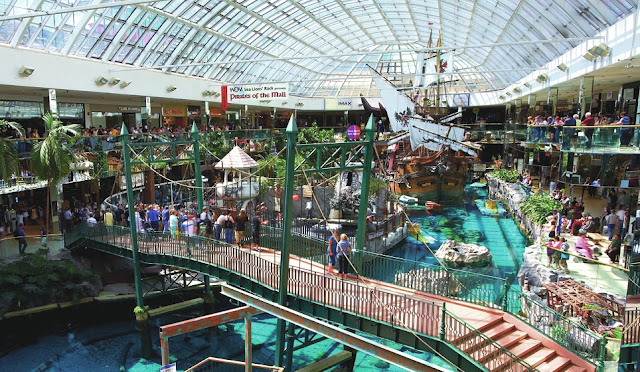The economic boom in Asia is reflected in the development of modern temples of consumerism. Nine out of ten of the world’s biggest shopping malls are located in Asia. Offering much more than “shop till you drop” opportunities – malls are becoming amusement parks and lifestyle centers surrounded by shops.
Emporis.com generated the Top 10 rankings, which are based on the gross leasable area, the area used for revenue-generating activities. Historically, malls have always been the icons of America – the first mall ever was built in Minneapolis in 1956.
However, Asia’s economic boom has resulted in the rise of consumerism and the development of mega-malls. Nowadays, Asia has more malls than America, and the two largest are located in China.
The dimensions of the malls is demonstrated in this comparison: the second biggest mall, Golden Resources Mall, has an area of 557.419 m², the size of about 75 soccer fields.
But some mega-malls in Asia are experiencing problems. New South China Mall is the biggest mall in the world with 600.153 m² of shopping space – most of it empty, with little consumer traffic and a high vacancy rate. It has been classified as a “dead mall”.
In recent years, developers have invented new ways for the mega-mall to survive in this economy. Gone is the store-dominated shopping centre welcoming instead, an age of mixed-use “lifestyle centers”. The Dubai Mall offers an ice-rink and aquarium on an area of 350.244 m². The Persian Gulf Complex, once completed, will house an indoor amusement park, prayer room, and helipad.
Another strategy calls for ways to combine environmental solutions with architecture. An indoor rainforest with koi ponds and the largest rooftop garden in Southeast Asia was implemented by 1 Utama mall in Malaysia. CentralWorld in Thailand features an indoor salt-water lake with sea lions. Trends to include office and residential space, such as the Cehavir Mall in Turkey, are also a survival method of mega-malls. BD+C
CLICK THE LINK BELOW TO VIEW THE TOP 10 LIST
Related Stories
Codes and Standards | May 3, 2024
New York City considering bill to prevent building collapses
The New York City Council is considering a proposed law with the goal of preventing building collapses. The Billingsley Structural Integrity Act is a response to the collapse of 1915 Billingsley Terrace in the Bronx last December.
Architects | May 2, 2024
Emerging considerations in inclusive design
Design elements that consider a diverse population of users make lives better. When it comes to wayfinding, some factors will remain consistent—including accessibility and legibility.
K-12 Schools | Apr 30, 2024
Fully electric Oregon elementary school aims for resilience with microgrid design
The River Grove Elementary School in Oregon was designed for net-zero carbon and resiliency to seismic events, storms, and wildfire. The roughly 82,000-sf school in a Portland suburb will feature a microgrid—a small-scale power grid that operates independently from the area’s electric grid.
AEC Tech | Apr 30, 2024
Lack of organizational readiness is biggest hurdle to artificial intelligence adoption
Managers of companies in the industrial sector, including construction, have bought the hype of artificial intelligence (AI) as a transformative technology, but their organizations are not ready to realize its promise, according to research from IFS, a global cloud enterprise software company. An IFS survey of 1,700 senior decision-makers found that 84% of executives anticipate massive organizational benefits from AI.
Codes and Standards | Apr 30, 2024
Updated document details methods of testing fenestration for exterior walls
The Fenestration and Glazing Industry Alliance (FGIA) updated a document serving a recommended practice for determining test methodology for laboratory and field testing of exterior wall systems. The document pertains to products covered by an AAMA standard such as curtain walls, storefronts, window walls, and sloped glazing. AAMA 501-24, Methods of Test for Exterior Walls was last updated in 2015.
MFPRO+ News | Apr 29, 2024
World’s largest 3D printer could create entire neighborhoods
The University of Maine recently unveiled the world’s largest 3D printer said to be able to create entire neighborhoods. The machine is four times larger than a preceding model that was first tested in 2019. The older model was used to create a 600 sf single-family home made of recyclable wood fiber and bio-resin materials.
K-12 Schools | Apr 29, 2024
Tomorrow's classrooms: Designing schools for the digital age
In a world where technology’s rapid pace has reshaped how we live, work, and communicate, it should be no surprise that it’s also changing the PreK-12 education landscape.
Adaptive Reuse | Apr 29, 2024
6 characteristics of a successful adaptive reuse conversion
In the continuous battle against housing shortages and the surplus of vacant buildings, developers are turning their attention to the viability of adaptive reuse for their properties.
AEC Innovators | Apr 26, 2024
National Institute of Building Sciences announces Building Innovation 2024 schedule
The National Institute of Building Sciences is hosting its annual Building Innovation conference, May 22-24 at the Capital Hilton in Washington, D.C. BI2024 brings together everyone who impacts the built environment: government agencies, contractors, the private sector, architects, scientists, and more.
Mass Timber | Apr 25, 2024
Bjarke Ingels Group designs a mass timber cube structure for the University of Kansas
Bjarke Ingels Group (BIG) and executive architect BNIM have unveiled their design for a new mass timber cube structure called the Makers’ KUbe for the University of Kansas School of Architecture & Design. A six-story, 50,000-sf building for learning and collaboration, the light-filled KUbe will house studio and teaching space, 3D-printing and robotic labs, and a ground-level cafe, all organized around a central core.

















